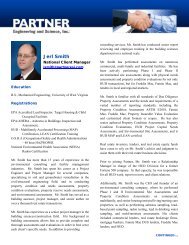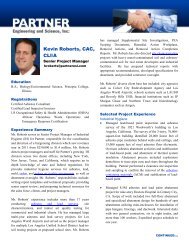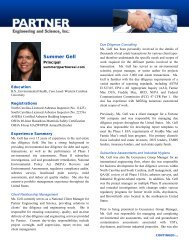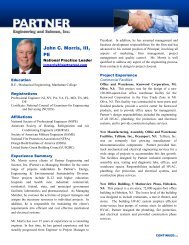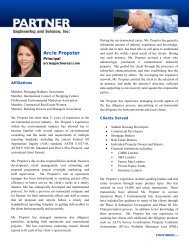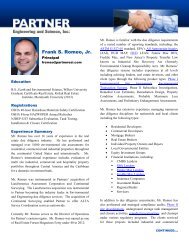Use of California Human Health Screening Levels (CHHSLs) in ...
Use of California Human Health Screening Levels (CHHSLs) in ...
Use of California Human Health Screening Levels (CHHSLs) in ...
Create successful ePaper yourself
Turn your PDF publications into a flip-book with our unique Google optimized e-Paper software.
examples <strong>in</strong>clude the soil direct-exposure CHHSL for diox<strong>in</strong> (e.g., 0.0000046mg/kg for residential exposure).2.7 Substitution <strong>of</strong> Naturally Occurr<strong>in</strong>g Concentrationsfor <strong>CHHSLs</strong>Naturally occurr<strong>in</strong>g background concentrations <strong>of</strong> arsenic, beryllium, cadmium,chromium and other metals <strong>in</strong> soils may exceed their respective soil <strong>CHHSLs</strong>.Cal/EPA generally does not require cleanup <strong>of</strong> soil to below background levels.This issue is frequently encountered with arsenic. Natural backgroundconcentrations <strong>of</strong> arsenic <strong>in</strong> <strong>California</strong> are <strong>of</strong>ten well above the health-based,direct-exposure goals <strong>in</strong> soil <strong>of</strong> 0.07 mg/kg for residential land use and 0.24mg/kg for commercial/<strong>in</strong>dustrial land use (e.g., Bradford et. al, 1996; LBNL2002). Background concentration <strong>of</strong> arsenic or other metals <strong>of</strong> potential concernat a site should be determ<strong>in</strong>ed from analysis <strong>of</strong> site-specific samples <strong>in</strong>uncontam<strong>in</strong>ated areas us<strong>in</strong>g guidance published by Cal/EPA and/or reference topublished data for nearby sites (Cal/EPA 1997). However, background data fornearby sites may only be used as a surrogate for uncontam<strong>in</strong>ated site data if thosedata are obta<strong>in</strong>ed from soil <strong>of</strong> the same lithology as that found on-site.2.8 Cumulative Risks at Sites with MultipleContam<strong>in</strong>antsRisks posed by exposure to multiple chemicals with similar health affects areconsidered to be additive or "cumulative." For example, the total excess lifetimerisk <strong>of</strong> cancer posed by the presence <strong>of</strong> several carc<strong>in</strong>ogenic chemicals <strong>in</strong> allexposure media is the sum <strong>of</strong> the risk posed by each <strong>in</strong>dividual chemical. Thesame is true for chemicals that cause noncarc<strong>in</strong>genic health effects.A stepwise approach for screen<strong>in</strong>g <strong>of</strong> sites with multiple contam<strong>in</strong>ants issuggested (after USEPA 2004):Step 1: Identify potential chemicals <strong>of</strong> concern.Step 2: Record <strong>CHHSLs</strong> for each chemical separated by media type (soil, soilgas and/or <strong>in</strong>door air). Include <strong>CHHSLs</strong> for both cancer and noncancereffects, if available (refer to Appendix 1). If <strong>CHHSLs</strong> are not availablefor specific chemicals, evaluate those chemicals us<strong>in</strong>g the approachesdiscussed <strong>in</strong> Appendix 1 and <strong>in</strong> the PEA manual.January 20052-10CHHSLS



